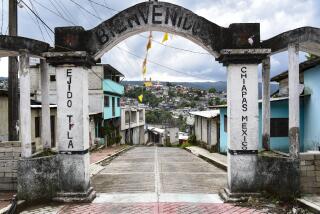U.S.-Guatemalan Ties Strained by One Woman’s Protest : Central America: Jennifer Harbury’s hunger strike aims to disprove claims that her rebel husband is dead.
- Share via
GUATEMALA CITY — A U.S. woman’s three-week hunger strike here to protest what she claims is the illegal detention of her guerrilla husband is putting a strain on Guatemala’s relations with the United States.
Jennifer Harbury, a 43-year-old Harvard Law School graduate who married guerrilla commander Efrain Bamaca in 1991, says she will continue her protest until her husband, missing since a battle in March, 1992, is handed over to the courts.
A cellular phone in one hand, Harbury has remained perched on blankets in this capital’s main square, across from the Presidential Palace. She gives frequent news conferences and receives visits from U.S. government officials and human rights activists. The hunger strike, which entered its 20th day Sunday, is Harbury’s second in just over a year; the first lasted six days.
The military and the government contend that Bamaca is dead, but Harbury says she believes he is being held in a clandestine army jail.
The case underscores the still-bleak human rights picture in Guatemala, where a long civil war claimed 100,000 lives, mostly civilians, in the 1980s. And it is angering the Guatemalan military, which in the last year has mounted a careful public relations campaign to alter its image as one of the most abusive armies in the hemisphere.
Guatemala’s ambassador to the United States, Edmund Mulet, who was recalled for consultations last week, said he is receiving a hundred calls a day about the case, presumably from Harbury’s well-organized support network. He said the case could threaten Guatemala’s preferential trading status with the United States.
In response to pressure, President Ramiro de Leon Carpio said Thursday that he will order a special investigation, despite his stated belief that Bamaca is dead.
Harbury’s demonstration is proving to be a headache as well for the U.S. government, which is trying to shore up De Leon’s 15-month-old administration. U.S. officials have also taken great pains not to alienate what they see as the modernizing elements in the Guatemalan army under the direction of Defense Minister Gen. Mario Enriquez.
But after first trying to downplay the case, the U.S. Embassy is adopting a more aggressive public role.
“The case is very important to the U.S. government because of the involvement of a U.S. citizen and because it addresses certain fundamental issues of human rights,” said John Hamill, an embassy spokesman. “We are disappointed there has not been more progress in the case but welcome the president’s initiative.”
De Leon, himself a former human rights ombudsman, took office after his predecessor tried to seize dictatorial powers in an ultimately unsuccessful coup. De Leon’s presidency raised hopes that Guatemala’s human rights record would improve and that its formal democracy would gain substance.
The government and the military signed a landmark human rights agreement in March as part of negotiations with Guatemala’s leftist guerrillas aimed at ending the 33-year war. But abuses have only increased, activists say.
In August, the Roman Catholic Church’s human rights office recorded 180 killings, at least 35 of them politically motivated, making it the worst month since the office opened five years ago.
Harbury argues that her husband’s case casts doubts on the military’s good faith.
Bamaca disappeared after a battle March 12, 1992. The army said he was wounded, killed himself to avoid capture and was buried.
But in January, 1993, Santiago Cabrera Lopez, another guerrilla who said he had escaped from army capture, told Harbury that he had seen her husband alive in military installations in 1992. Cabrera claimed that Bamaca was one of 36 rebels being held by the military in clandestine jails as part of a plan to break them down and use them as informants.
Harbury also says peasants in the western area of San Marcos and members of guerrilla counterintelligence have spotted Bamaca on numerous occasions since, usually entering or leaving a military base under heavy guard.
The military denies it is holding rebels or that clandestine jails exist, and has called the Harbury demonstration a guerrilla “show.”
But the claim that Bamaca was buried has proved false. An exhumation in August, 1993, unearthed a shorter, younger man who appeared to have been shot with his hands tied behind his back.
Cabrera is due to testify this week before the Organization of American States. He has given Harbury names of the military personnel, including a colonel and a major, who he claims captured and tortured Bamaca. At least two, Harbury says, are graduates of the School of the Americas at Ft. Benning, Ga.
As a guerrilla for 17 years until his disappearance, Bamaca was a potential gold mine for military intelligence. “He knows every (rebel) face, every trail, every source of guns,” Harbury said. “He knows everything.”
More to Read
Sign up for Essential California
The most important California stories and recommendations in your inbox every morning.
You may occasionally receive promotional content from the Los Angeles Times.










